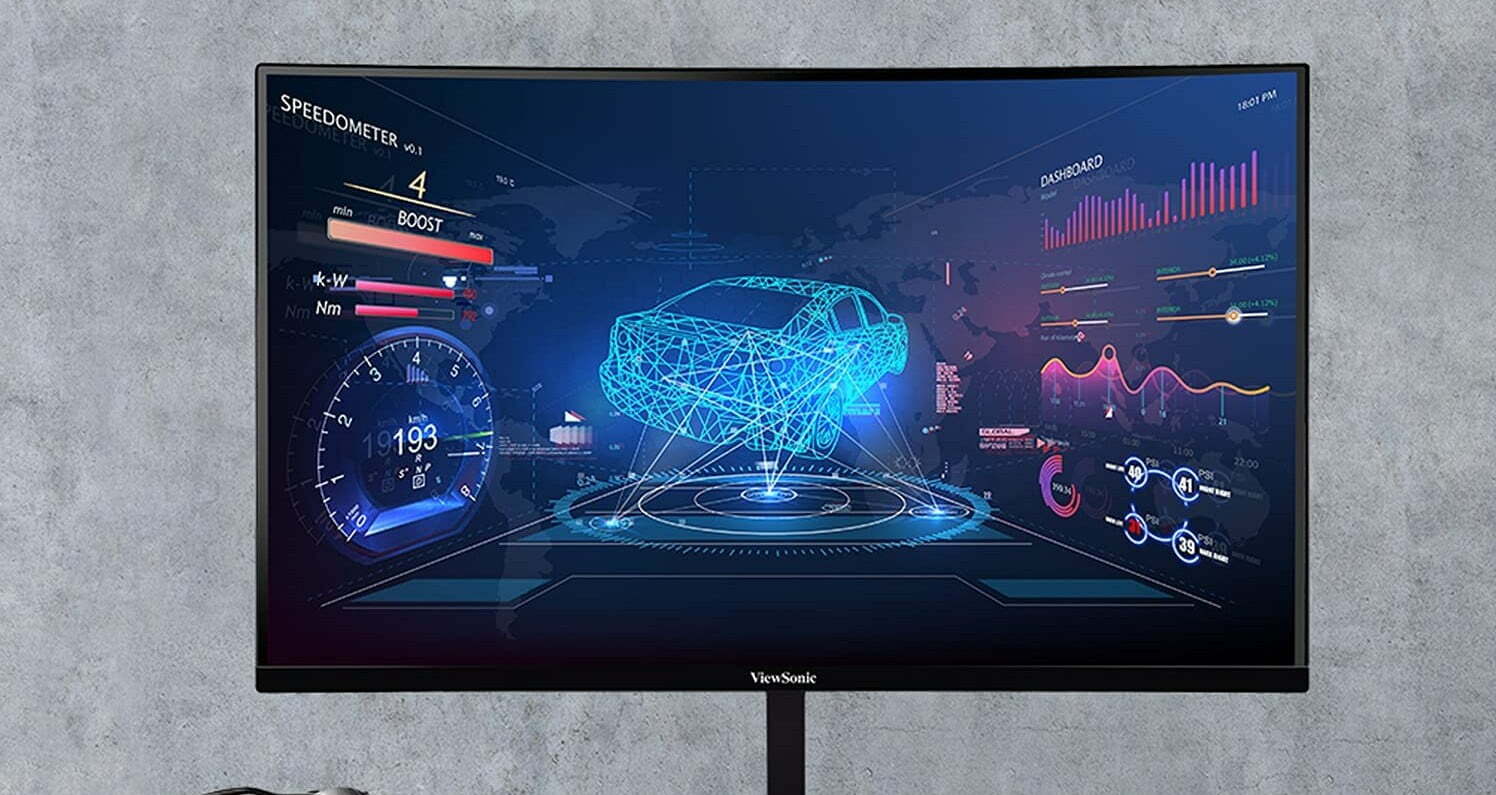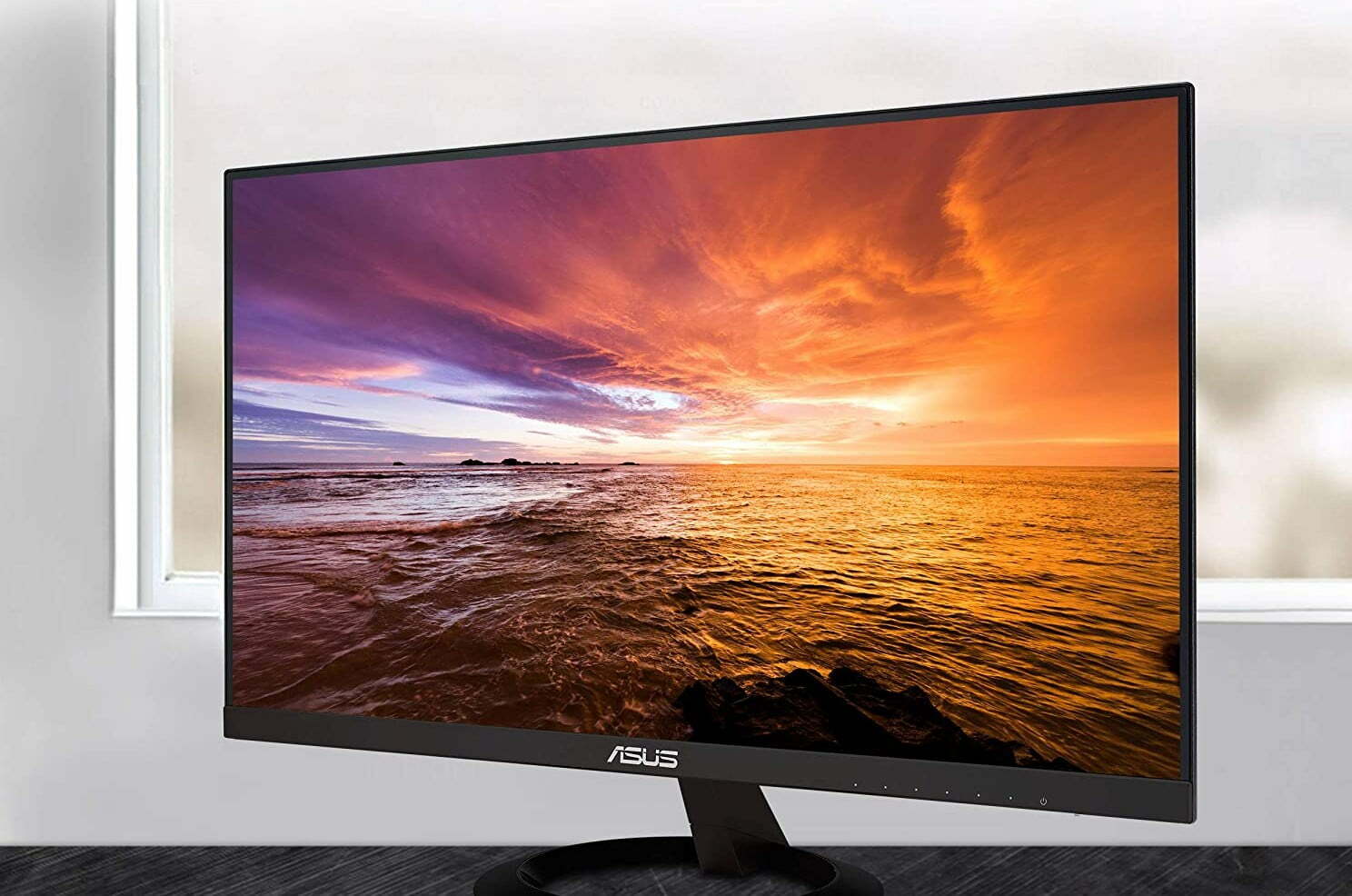If you are shopping for a new display, you may be comparing a TV vs a computer monitor. The best computer monitors, after all, may include features that the best television cannot offer, and vice versa. Keep reading to learn the differences between TVs and computer monitors.
KEY TAKEAWAYS:
- Televisions are great display types for easily streaming video content, especially smart televisions.
- TVs are generally much larger than computer monitors, with screens that go up to 70-inches and above, offering comparable pixel density and pixels per inch metrics.
- Computer monitors tend to offer much faster response times, lower input lag, and faster refresh rates, which comes in handy while gaming.
Differences Between TVs and Computer Monitors
There are many differences when it comes time to compare standard televisions and dedicated computer monitors. Televisions are designed for bright and bold colors, which can come in handy in some instances, but they aren’t known for offering the kind of response times competitive gamers are looking for. Yet, this isn’t the same for a monitor, which can handle quick on-screen motion, and provide rich details and color accuracy. You can find out more in our resource article discussing how to use a computer monitor as a TV.
Screen Size
When shopping for a computer monitor, you may be stuck comparing 24 vs 27-inch monitor sizes. In other words, computer monitors are not that big. Televisions, on the other hand, are absolutely gigantic. Modern HDTVs can go up to 70-inches or larger in some cases. To get that kind of immersion with a computer monitor, you will have to start comparing two monitors vs ultrawide monitors. The increased screen real estate makes TVs the absolute champ when it comes to watching streaming content, such as your favorite movies. Additionally, the image on the monitor may seem significantly different compared to that of a TV. This difference stems from the varying aspect ratios, size, color preferences, and the backlight panel type. The aspect ratio of a monitor is about 4:3, making the screen appear more square. Brands also make smaller monitors than they do TVs.
Insider Tip
Many modern TVs can actually act as computer monitors, so long as you have the correct connection cables.
Responsiveness
Computer monitors, particularly gaming monitors, are designed from the ground up to offer blazing-fast response times. The same cannot be said for televisions. Your average computer monitor can offer response times in the 0.5ms to 1ms area, whereas average TVs offer response times in the area of 5ms to 8ms. That is a fairly stark difference that will certainly come into play with computer games and other computing tasks in which responsiveness is key.
Resolution
Both modern computer monitors and newly released smart TVs offer high resolutions, with neither option boasting a significant advantage over the other. However, a computer’s GPU and related processors will have to handle all of those pixels, so 4K monitors could offer slower response times and refresh rates while gaming and performing other graphics-intensive tasks. Televisions are typically not hampered too much by these metrics. When it comes to image appearance, TVs typically have a more cinematic appearance than monitors. Today’s TVs often have an aspect ratio of 16:9, meaning they are significantly wider than tall. Additionally, consumers want larger TVs because of how far they sit when watching one. If you’re trying to stick a 60-inch HDTV on a desk, you’re more likely to end up with headaches and eye strain. When you combine these two aspects, you end up with a wider viewing angle, which measures the angle at which you can see a consistent image from the TV. And if you are in the market for a new TV, consider donating your old one.
Colors
The colors on a TV also differ from those on a monitor because TVs feature vivid colors. Brands prefer the colors to be more dramatic and cinematic on a TV. This difference often results in an image that still looks realistic but does not represent the world in the same way. The pictures on a TV seem smoother than the sharp images of a monitor. TVs provide more consistency when it comes to brightness along each area of the screen. This consistency stems from the fact that most TVs use a full array panel with local dimming that allows certain screen areas to have significantly less light bleed-in. Also, lots of TVs offer the SAP service. This is useful for those with visual disabilities. The colors on the screen of a monitor may seem accurate to what you would see in real life, but they usually contain an edge-lit panel type, which can cause ambiguity in dark areas of the screen.
Cost
You can find budget-friendly models in both categories, though you can buy larger TVs for much cheaper than you can buy larger-than-average computer monitors. Of course, when it comes to computer monitors, you may not even need a large display, which you can find in our list of the high-end 24-inch monitors, as you will likely be sitting directly in front of it.
F.A.Q.S
What is the difference between an LCD TV and an LCD Monitor?
The differences stem from the fact that they are built to different standards. For example, TVs are typically wider and larger, with wider viewing angles and fewer pixels per inch. As a result, a monitor displays images sharper than a TV with realistic colors, higher refresh rates, and lower input lag.
Why is a monitor better than a TV for computers?
A monitor is better for computers because it has less input lag, which refers to the amount of time it takes for user input to show on the screen.
Do gaming monitors deliver good sound or do I need external speakers?
Not necessarily. Gaming monitors are not known for having the most powerful speakers, so you should look into external speakers.
Why monitors are better than TVs for gaming?
It all boils down to lower input lag, higher response time, and the inclusion of variable refresh rate. Though TVs tend to integrate better with gaming consoles and their console games, with wider viewing angles.
Do gaming monitors need USB-C?
Not always. Modern gaming monitors offer plenty of connectivity options, including HDMI cable ports, USB-C ports, DisplayPort, and more.
STAT: In the second quarter of 2021, Dell’s shipments of PC monitors amounted to about 7.55 million units, whilst those of Lenovo reached 4.16 million shipments. TVP ranked third among vendors with 3.71 million PC monitor shipments. (source)


































![Best 27 Inch Computer Monitor in [year] 27 Best 27 Inch Computer Monitor in 2025](https://www.gadgetreview.dev/wp-content/uploads/how-to-buy-the-best-computer-monitor.jpg)
![Best BenQ Monitors in [year] 28 Best BenQ Monitors in 2025](https://www.gadgetreview.dev/wp-content/uploads/best-benq-monitor-image.jpg)
![Best ASUS Monitors in [year] 29 Best ASUS Monitors in 2025](https://www.gadgetreview.dev/wp-content/uploads/best-asus-monitor-image.jpg)
![Best Dell Monitors in [year] 30 Best Dell Monitors in 2025](https://www.gadgetreview.dev/wp-content/uploads/best-dell-monitor-image.jpg)
![Best HP Monitors in [year] 31 Best HP Monitors in 2025](https://www.gadgetreview.dev/wp-content/uploads/best-hp-monitor-image.jpg)
![Best Lenovo Monitors in [year] 32 Best Lenovo Monitors in 2025](https://www.gadgetreview.dev/wp-content/uploads/best-lenovo-monitor-image.jpg)
![Best ViewSonic Monitors in [year] 33 Best ViewSonic Monitors in 2025](https://www.gadgetreview.dev/wp-content/uploads/best-viewsonic-monitor-image.jpg)
![Best Gigabyte Monitors in [year] 34 Best Gigabyte Monitors in 2025](https://www.gadgetreview.dev/wp-content/uploads/best-gigabyte-monitor-image.jpg)
![Best Monitors for PS4 Pro Gaming in [year] 35 Best Monitors for PS4 Pro Gaming in 2025](https://www.gadgetreview.dev/wp-content/uploads/best-monitors-for-ps4-pro-image.jpg)
![Best Monitor for Xbox Series X in [year] 36 Best Monitor for Xbox Series X in 2025](https://www.gadgetreview.dev/wp-content/uploads/best-monitor-for-xbox-series-x-image.jpg)
![Best Acer Monitors in [year] 37 Best Acer Monitors in 2025](https://www.gadgetreview.dev/wp-content/uploads/best-acer-monitor-image.jpg)
![Best MSI Monitors in [year] 38 Best MSI Monitors in 2025](https://www.gadgetreview.dev/wp-content/uploads/best-msi-monitor-image.jpg)
![Best SAMSUNG Monitors in [year] 39 Best SAMSUNG Monitors in 2025](https://www.gadgetreview.dev/wp-content/uploads/best-samsung-monitor-image.jpg)
![Best LG Monitors in [year] 40 Best LG Monitors in 2025](https://www.gadgetreview.dev/wp-content/uploads/best-lg-monitor-image.jpg)
![Best AOC Monitors in [year] 41 Best AOC Monitors in 2025](https://www.gadgetreview.dev/wp-content/uploads/best-aoc-monitor-image.jpg)
![Best Philips Monitors in [year] 42 Best Philips Monitors in 2025](https://www.gadgetreview.dev/wp-content/uploads/best-philips-monitors-image.jpg)
![Best Monitors For PUBG in [year] 43 Best Monitors For PUBG in 2025](https://www.gadgetreview.dev/wp-content/uploads/best-monitor-for-pubg-image.jpg)
![Best Stream Decks in [year] 44 Best Stream Decks in 2025](https://www.gadgetreview.dev/wp-content/uploads/best-stream-deck-image.jpg)
![Best Monitors for Streaming in [year] 45 Best Monitors for Streaming in 2025](https://www.gadgetreview.dev/wp-content/uploads/best-monitor-for-streaming-image.jpg)
![Best Monitors For Flight Simulator in [year] 46 Best Monitors For Flight Simulator in 2025](https://www.gadgetreview.dev/wp-content/uploads/best-monitor-for-flight-simulator-image.jpg)




















